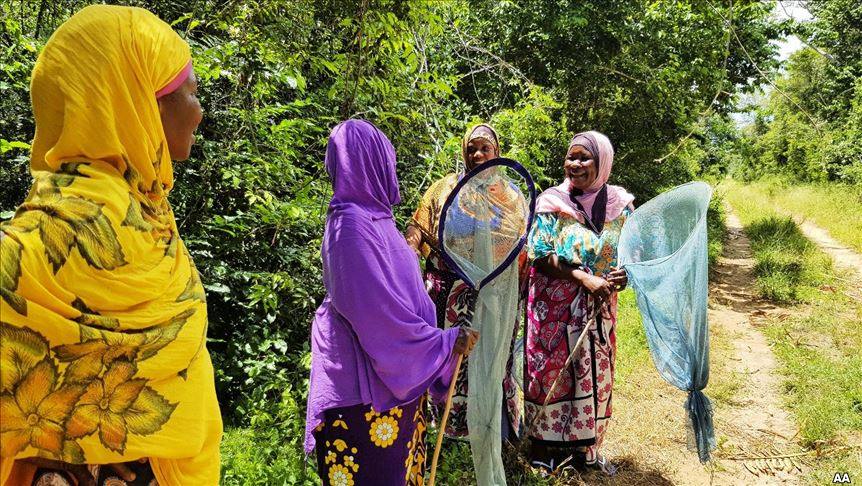Wed 20 November 2019:
Butterflies are empowering and transforming the lives of many women in the village of Gede on the eastern coast of Kenya.
Gede is well-known for its ancient ruins which consist of mansions, mosques and houses that are estimated to be around 800 years old.
Muslim women from a community-based enterprise in Gede dubbed the Kipepeo Project which supports people’s livelihoods are selling high-quality and diverse butterflies and moth pupae to international markets — mostly Europe and America, with the U.K. and Turkey being their biggest markets — thus fighting against poverty and becoming empowered.
Most of them, like Rehema Hassan, are uneducated and rely on the lucrative butterfly business to pay school fees for their children and cater for their daily needs.
The women are armed with butterfly hunting gear. Some lay traps in trees while others use homemade nets with handles.
They scour the forests for butterflies, being careful to avoid the many elephant corridors. Hassan said the key is not injuring the butterflies by using cheap nets.
She said that in the past, she used to sell firewood and charcoal.
“I used to rely on the charcoal business. I would cut down trees…We are surrounded by forests, you know, but now I conserve my environment because without the flowering trees, there cannot be any butterflies,” said Hassan, sporting a multicolored hijab.
Charcoal is one of the most common forms of cooking fuel used by communities that live next to the forest. They make it by cutting trees. The trees are partially burnt and buried in the earth, where they slowly burn. By the time they cool, they become charcoal.
Hassan struggled to seize a butterfly that was fluttering its wings inside a stationary butterfly trap. After a few seconds, with a gentle clutch, her hand revealed an iridescent glow from a dancing Charaxes butterfly.
She carefully placed the fragile insect in a net-like basket where it joined around a dozen others, all with vivid colors.
The thirsty new recruit folded its wings gently upward and drank nectar from fresh flowers that she had prepared early that morning.
Just beside the butterfly was a Papilio demodocus, or citrus swallowtail. It was flapping its white polka dot-filled wings with two spots as red as a cherry and fading black edges.
Hassan explained that to them, the butterfly business is all about conservation.
“Our forests are now places where we conserve and protect. They need us as much as we need them. Two of my children went through university through this business. That is why to us, the butterflies are everything.”
– No forests, no butterflies
Fatuma Hamisi is also a beneficiary. She told Anadolu Agency how the whole process works.
“We set up traps in the forests to capture the butterflies. We feed them until they lay their eggs, which hatch into caterpillars. The caterpillars eat the forest leaves until they turn into the pupae state, where they cocoon themselves. It is at this point that we sell them before they hatch into butterflies,” she said.
“We protect the forests because no forests, no butterflies.”
Hamisi said that mostly they release the butterfly that laid the eggs into the wild because they take long to lay eggs again, especially in confinement.
Charo Ngumbao, who heads the community project, told Anadolu Agency that their main market is the United Kingdom, “and the second one which right now is taking the butterfly pupae is Turkey.”
“They have a high demand for the Papillion and Charaxes butterfly species. Right now, they [Turkey] are taking butterflies every Monday, and the U.K. is taking butterflies on Friday,” he said, noting that they export butterflies twice a week.
“Butterflies usually live for a few weeks depending on their species, size and surroundings. There is high demand due to the short shelf life.”
According to the United Nations Programme on Reducing Emissions from Deforestation and Forest Degradation (UN-REDD), the project’s main aim is to link development and conservation.
Speaking to Anadolu Agency, the UN’s Griet Ingrid Dierckxsens explained how conservation comes into play in the project.
“This project is a very good example of the kinds of policies that UN-REDD is following. People need a livelihood. In order to stop people from cutting forests, which are carbon sinks, they have to see what is important about the forests,” she said.
“They make a lot of money from the exports — more than they would make selling charcoal and timber from trees. An annual return in this project is like $1.9 million. This is an incentive for them to protect their forests.”
Hamisi joked that aside from running away from elephants, their key challenge is getting modern butterfly catching equipment and competing with other countries that are in the butterfly export business. She said sometimes they have to lower their prices in order to sell butterflies similar to those exported from other countries.
Around 200 pupae can be sold for 13,000 Kenyan shillings (roughly US$130). A single butterfly can lay up to 500 eggs. In the wild, only one out of 20 of these eggs will grow to adulthood, whereas in controlled spaces, the chances of survivability are greatly increased.
They do not always sell the pupae of butterflies. Sometimes they release them into the wild to increase their numbers.
Kenya’s coastal forests are home to over 230 species of butterflies. Kenya as a whole has more than 800 species.
-AA
Think your friends would be interested? Share this story!





